This is an old revision of this page, as edited by Scalhotrod (talk | contribs) at 20:41, 15 March 2015 (Reverted 1 pending edit by 178.85.216.115 to revision 651529864 by Scalhotrod: WP:UNDUE for Lead). The present address (URL) is a permanent link to this revision, which may differ significantly from the current revision.
Revision as of 20:41, 15 March 2015 by Scalhotrod (talk | contribs) (Reverted 1 pending edit by 178.85.216.115 to revision 651529864 by Scalhotrod: WP:UNDUE for Lead)(diff) ← Previous revision | Latest revision (diff) | Newer revision → (diff) This article is about the friar and patron saint. For other uses, see Francis of Assisi (disambiguation).| Saint Francis of Assisi, O.F.M. | |
|---|---|
 Stigmata of St Francis Stigmata of St Francis tempera on panel by Bartolomeo della Gatta (1487) | |
| Religious, deacon, confessor and religious founder | |
| Born | Giovanni di Bernardone 1181 or 1182 Assisi, Duchy of Spoleto, Holy Roman Empire |
| Died | October 3, 1226 (age 44) Assisi, Umbria, Papal States |
| Venerated in | Roman Catholic Church Anglican Communion Lutheran Church Old Catholic Church |
| Canonized | July 16, 1228, Assisi, Italy by Pope Gregory IX |
| Major shrine | Basilica of San Francesco d'Assisi |
| Feast | October 4 |
| Attributes | Tau cross, dove, birds, animals, wolf at feet, Pax et Bonum, Poor Franciscan habit, stigmata |
| Patronage | animals; the environment; Italy; merchants; stowaways; Cub Scouts; San Francisco, California |
Saint Francis of Assisi (Template:Lang-it; born Giovanni di Pietro di Bernardone, but nicknamed Francesco ("the Frenchman") by his father; 1181/1182 – October 3, 1226) was an Italian Catholic friar and preacher. He founded the men's Order of Friars Minor, the women’s Order of St. Clare, and the Third Order of Saint Francis for men and women not able to live the lives of itinerant preachers, followed by the early members of the Order of Friars Minor, or the monastic lives of the Poor Clares. Francis is one of the most venerated religious figures in history.
Francis' father was Pietro di Bernardone, a prosperous silk merchant. Francis lived the high-spirited life typical of a wealthy young man, even fighting as a soldier for Assisi. While going off to war in 1204, Francis had a vision that directed him back to Assisi, where he lost his taste for his worldly life. On a pilgrimage to Rome, he joined the poor in begging at St. Peter's Basilica. The experience moved him to live in poverty. Francis returned home, began preaching on the streets, and soon gathered followers. His Order was authorized by Pope Innocent III in 1210. He then founded the Order of Poor Clares, which became an enclosed religious order for women, as well as the Order of Brothers and Sisters of Penance (commonly called the Third Order).
In 1219, he went to Egypt in an attempt to convert the Sultan to put an end to the conflict of the Crusades. By this point, the Franciscan Order had grown to such an extent that its primitive organizational structure was no longer sufficient. He returned to Italy to organize the Order. Once his community was authorized by the Pope, he withdrew increasingly from external affairs. In 1223, Francis arranged for the first Christmas nativity scene. In 1224, he received the stigmata, making him the first recorded person to bear the wounds of Christ's Passion. He died during the evening hours of October 3, 1226, while listening to a reading he had requested of Psalm 142(141).
On July 16, 1228, he was proclaimed a saint by Pope Gregory IX. He is known as the patron saint of animals and the environment, and is one of the two patron saints of Italy (with Catherine of Siena). It is customary for Catholic and Anglican churches to hold ceremonies blessing animals on his feast day of October 4. He is also known for his love of the Eucharist, his sorrow during the Stations of the Cross, and for the creation of the Christmas crèche or Nativity Scene.
Early life


Francis of Assisi was one of seven children born in late 1181 or early 1182 to Pietro and his wife Pica de Bourlemont, about whom little is known except that she was a noblewoman originally from Provence. Pietro was in France on business when Francis was born in Assisi, and Pica had him baptized as Giovanni. When his father returned to Assisi, he took to calling him Francesco ("the Frenchman"), possibly in honor of his commercial success and enthusiasm for all things French. Since the child was renamed in infancy, the change can hardly have had anything to do with his aptitude for learning French, as some have thought. As a youth, Francesco became a devotee of troubadours and was fascinated with all things Transalpine. Although many hagiographers remark about his bright clothing, rich friends, and love of pleasures, his displays of disillusionment toward the world that surrounded him came fairly early in his life, as is shown in the "story of the beggar." In this account, he was selling cloth and velvet in the marketplace on behalf of his father when a beggar came to him and asked for alms. At the conclusion of his business deal, Francis abandoned his wares and ran after the beggar. When he found him, Francis gave the man everything he had in his pockets. His friends quickly chided and mocked him for his act of charity. When he got home, his father scolded him in rage.
In 1201, he joined a military expedition against Perugia and was taken as a prisoner at Collestrada, spending a year as a captive. It is possible that his spiritual conversion was a gradual process rooted in this experience. Upon his return to Assisi in 1203, Francis returned to his carefree life. In 1204, a serious illness led him to a spiritual crisis. In 1205, Francis left for Apulia to enlist in the army of Walter III, Count of Brienne. A strange vision made him return to Assisi, deepening his ecclesiastical awakening.

According to the hagiographic legend, thereafter he began to avoid the sports and the feasts of his former companions. In response, they asked him laughingly whether he was thinking of marrying, to which he answered, "yes, a fairer bride than any of you have ever seen," meaning his "Lady Poverty". He spent much time in lonely places, asking God for enlightenment. By degrees he took to nursing lepers, the most repulsive victims in the lazar houses near Assisi. After a pilgrimage to Rome, where he joined the poor in begging at the doors of the churches, he said he had a mystical vision of Jesus Christ in the country chapel of San Damiano, just outside of Assisi, in which the Icon of Christ Crucified said to him, "Francis, Francis, go and repair My house which, as you can see, is falling into ruins." He took this to mean the ruined church in which he was presently praying, and so he sold some cloth from his father's store to assist the priest there for this purpose.
His father, Pietro, highly indignant, attempted to change his mind, first with threats and then with beatings. In the midst of legal proceedings before the Bishop of Assisi, Francis renounced his father and his patrimony, laying aside even the garments he had received from him in front of the public. For the next couple of months he lived as a beggar in the region of Assisi. Returning to the countryside around the town for two years, he embraced the life of a penitent, during which he restored several ruined chapels in the countryside around Assisi, among them the Porziuncola, the little chapel of St. Mary of the Angels just outside the town, which later became his favorite abode.
Founding of the Franciscan Order

At the end of this period (on February 24, 1209, according to Jordan of Giano), Francis heard a sermon that changed his life forever. The sermon was about Matthew 10:9, in which Christ tells his followers they should go forth and proclaim that the Kingdom of Heaven was upon them, that they should take no money with them, nor even a walking stick or shoes for the road. Francis was inspired to devote himself to a life of poverty.
Clad in a rough garment, barefoot, and, after the Gospel precept, without staff or scrip, he began to preach repentance. He was soon joined by his first follower, a prominent fellow townsman, the jurist Bernardo di Quintavalle, who contributed all that he had to the work. Within a year Francis had eleven followers. Francis chose never to be ordained a priest, and the community lived as "lesser brothers," fratres minores in Latin. The brothers lived a simple life in the deserted lazar house of Rivo Torto near Assisi; but they spent much of their time wandering through the mountainous districts of Umbria, always cheerful and full of songs, yet making a deep impression upon their hearers by their earnest exhortations.
Francis' preaching to ordinary people was unusual since he had no license to do so. In 1209 he composed a simple rule for his followers ("friars"), the Regula primitiva or “Primitive Rule”, which came from verses in the Bible.
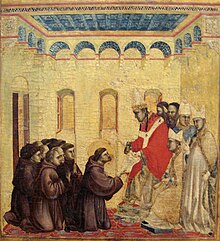
The rule was “To follow the teachings of our Lord Jesus Christ and to walk in his footsteps.” In 1209, Francis led his first eleven followers to Rome to seek permission from Pope Innocent III to found a new religious Order. Upon entry to Rome, the brothers encountered Bishop Guido of Assisi, who had in his company Giovanni di San Paolo, the Cardinal Bishop of Sabina. The Cardinal, who was the confessor of Pope Innocent III, was immediately sympathetic to Francis and agreed to represent Francis to the pope. Reluctantly, Pope Innocent agreed to meet with Francis and the brothers the next day. After several days, the pope agreed to admit the group informally, adding that when God increased the group in grace and number, they could return for an official admittance. The group was tonsured. This was important in part because it recognized Church authority and prevented his following from possible accusations of heresy, as had happened to the Waldensians decades earlier. Though Pope Innocent initially had his doubts, following a dream in which he saw Francis holding up the Basilica of St. John Lateran (the cathedral of Rome, thus the 'home church' of all Christendom), he decided to endorse Francis' Order. This occurred, according to tradition, on April 16, 1210, and constituted the official founding of the Franciscan Order. The group, then the "Lesser Brothers" (Order of Friars Minor also known as the Franciscan Order), preached on the streets and had no possessions. They were centered in the Porziuncola and preached first in Umbria, before expanding throughout Italy.
Missions work

From then on, the new Order grew quickly with new vocations. When hearing Francis preaching in the church of San Rufino in Assisi in 1211, Clare of Assisi became deeply touched by his message and she realized her calling. Her cousin Rufino, the only male member of the family in their generation, also joined the new Order. On the night of Palm Sunday, March 28, 1212, Clare sneaked out of her family's palace. Francis received Clare at the Porziuncola and hereby established the Order of Poor Ladies, later called Poor Clares. This was an Order for women, and he gave a religious habit, or dress, similar to his own to the noblewoman later known as St. Clare of Assisi, before he then lodged her and a few companions in a nearby monastery of Benedictine nuns. Later he transferred them to San Damiano. There they were joined by many other women of Assisi. For those who could not leave their homes, he later formed the Third Order of Brothers and Sisters of Penance. This was a fraternity composed of either laity or clergy whose members neither withdrew from the world nor took religious vows. Instead, they carried out the principles of Franciscan life in their daily lives. Before long this Order grew beyond Italy.
Determined to bring the Gospel to all God's creatures, Francis sought on several occasions to take his message out of Italy. In the late spring of 1212, he set out for Jerusalem, but he was shipwrecked by a storm on the Dalmatian coast, forcing him to return to Italy. On May 8, 1213, he was given the use of the mountain of La Verna (Alverna) as a gift from Count Orlando di Chiusi, who described it as “eminently suitable for whoever wishes to do penance in a place remote from mankind.” The mountain would become one of his favourite retreats for prayer.

In the same year, Francis sailed for Morocco, but this time an illness forced him to break off his journey in Spain. Back in Assisi, several noblemen (among them Tommaso da Celano, who would later write the biography of St. Francis) and some well-educated men joined his Order. In 1215, Francis went again to Rome for the Fourth Lateran Council. During this time, he probably met a canon, Dominic de Guzman (later to be Saint Dominic, the founder of the Friars Preachers, another Catholic religious order). In 1217, he offered to go to France. Cardinal Ugolino of Segni (the future Pope Gregory IX), an early and important supporter of Francis, advised him against this and said that he was still needed in Italy.
In 1219, accompanied by another friar and hoping to convert the Sultan of Egypt or win martyrdom in the attempt, Francis went to Egypt where a Crusader army had been encamped for over a year besieging the walled city of Damietta two miles (3.2 km) upstream from the mouth of one of the main channels of the Nile. The Sultan, al-Kamil, a nephew of Saladin, had succeeded his father as Sultan of Egypt in 1218 and was encamped upstream of Damietta, unable to relieve it. A bloody and futile attack on the city was launched by the Christians on August 29, 1219, following which both sides agreed to a ceasefire which lasted four weeks. It was most probably during this interlude that Francis and his companion crossed the Saracen lines and were brought before the Sultan, remaining in his camp for a few days. The visit is reported in contemporary Crusader sources and in the earliest biographies of Francis, but they give no information about what transpired during the encounter beyond noting that the Sultan received Francis graciously and that Francis preached to the Saracens without effect, returning unharmed to the Crusader camp. No contemporary Arab source mentions the visit. One detail, added by Bonaventure in the official life of Francis (written forty years after the event), concerns an alleged challenge by Francis offering trial-by-fire in order to prove the veracity of the Christian Gospel.
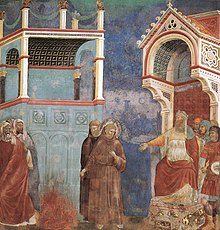
Although Bonaventure does not suggest as much, subsequent biographies went further, claiming that a fire was kindled which Francis unhesitatingly entered without suffering burns. Such an incident is depicted in the late 13th-century fresco cycle, attributed to Giotto, in the upper basilica at Assisi (see accompanying illustration). The statuettes on the fresco relate to late-antique power representation and emphasizes the worldly authority of the sultan, as opposed to the spirituality of Francis. According to some late sources, the Sultan gave Francis permission to visit the sacred places in the Holy Land and even to preach there. All that can safely be asserted is that Francis and his companion left the Crusader camp for Acre, from where they embarked for Italy in the latter half of 1220. Drawing on a 1267 sermon by Bonaventure, later sources report that the Sultan secretly converted or accepted a death-bed baptism as a result of the encounter with Francis. The Franciscan Order has been present in the Holy Land almost uninterruptedly since 1217 when Brother Elias arrived at Acre. It received concessions from the Mameluke Sultan in 1333 with regard to certain Holy Places in Jerusalem and Bethlehem, and (so far as concerns the Catholic Church) jurisdictional privileges from Pope Clement VI in 1342.
At Greccio near Assisi, around 1220, Francis celebrated Christmas by setting up the first known presepio or crèche (Nativity scene). His nativity imagery reflected the scene in traditional paintings. He used real animals to create a living scene so that the worshipers could contemplate the birth of the child Jesus in a direct way, making use of the senses, especially sight. Thomas of Celano, a biographer of Francis and Saint Bonaventure both, tell how he used only a straw-filled manger (feeding trough) set between a real ox and donkey. According to Thomas, it was beautiful in its simplicity, with the manger acting as the altar for the Christmas Mass.
Reorganization of the Franciscan Order and death

By this time, the growing Order of friars was divided into provinces and groups were sent to France, Germany, Hungary, and Spain and to the East. Upon receiving a report of the martyrdom of five brothers in Morocco, Francis returned to Italy via Venice. Cardinal Ugolino di Conti was then nominated by the Pope as the protector of the Order. Another reason for Francis' return to Italy was that the friars in Italy were causing problems. The Franciscan Order had grown at an unprecedented rate compared to prior religious orders, but its organizational sophistication had not kept up with this growth and had little more to govern it than Francis' example and simple rule. To address this problem, Francis prepared a new and more detailed Rule, the "First Rule" or "Rule Without a Papal Bull" (Regula prima, Regula non bullata), which again asserted devotion to poverty and the apostolic life. However, it also introduced greater institutional structure though this was never officially endorsed by the pope.
On September 29, 1220, Francis handed over the governance of the Order to Brother Peter Catani at the Porziuncola, but Brother Peter died only five months later, on March 10, 1221, and was buried there. When numerous miracles were attributed to the deceased brother, people started to flock to the Porziuncola, disturbing the daily life of the Franciscans. Francis then prayed, asking Peter to stop the miracles and to obey in death as he had obeyed during his life.

The reports of miracles ceased. Brother Peter was succeeded by Brother Elias as Vicar of Francis. Two years later, Francis modified the "First Rule", creating the "Second Rule" or "Rule With a Bull", which was approved by Pope Honorius III on November 29, 1223. As the official Rule of the Order, it called on the friars "to observe the Holy Gospel of our Lord Jesus Christ, living in obedience without anything of our own and in chastity". In addition, it set regulations for discipline, preaching, and entry into the Order. Once the Rule was endorsed by the Pope, Francis withdrew increasingly from external affairs. During 1221 and 1222, Francis crossed Italy, first as far south as Catania in Sicily and afterwards as far north as Bologna.
While he was praying on the mountain of Verna, during a forty-day fast in preparation for Michaelmas (September 29), Francis is said to have had a vision on or about September 14, 1224, the Feast of the Exaltation of the Cross, as a result of which he received the stigmata. Brother Leo, who had been with Francis at the time, left a clear and simple account of the event, the first definite account of the phenomenon of stigmata. "Suddenly he saw a vision of a seraph, a six-winged angel on a cross. This angel gave him the gift of the five wounds of Christ." Suffering from these stigmata and from trachoma, Francis received care in several cities (Siena, Cortona, Nocera) to no avail. In the end, he was brought back to a hut next to the Porziuncola. Here, in the place where it all began, feeling the end approaching, he spent the last days of his life dictating his spiritual Testament. He died on the evening of Saturday, October 3, 1226, singing Psalm 142 (141), "Voce mea ad Dominum". On July 16, 1228, he was pronounced a saint by Pope Gregory IX (the former cardinal Ugolino di Conti, friend of St. Francis and Cardinal Protector of the Order). The next day, the Pope laid the foundation stone for the Basilica of Saint Francis in Assisi. Francis was buried on May 25, 1230, under the Lower Basilica, but his tomb was soon hidden on orders of Brother Elias to protect it from Saracen invaders. His exact burial place remained unknown until it was re-discovered in 1818. Pasquale Belli then constructed for the remains a crypt in neo-classical style in the Lower Basilica. It was refashioned between 1927 and 1930 into its present form by Ugo Tarchi, stripping the wall of its marble decorations. In 1978, the remains of St. Francis were examined and confirmed by a commission of scholars appointed by Pope Paul VI, and put into a glass urn in the ancient stone tomb.
Character and legacy

It has been argued that no one else in history was as dedicated as Francis to imitate the life, and carry out the work of Christ, in Christ’s own way. This is important in understanding Francis' character and his affinity for the Eucharist and respect for the priests who carried out the sacrament.
He and his followers celebrated and even venerated poverty. Poverty was so central to his character that in his last written work, the Testament, he said that absolute personal and corporate poverty was the essential lifestyle for the members of his Order.
He believed that nature itself was the mirror of God. He called all creatures his “brothers” and “sisters,” and even preached to the birds and supposedly persuaded a wolf to stop attacking some locals if they agreed to feed the wolf. In his “Canticle of the Creatures” (“Praises of Creatures” or “Canticle of the Sun”), he mentioned the “Brother Sun” and “Sister Moon,” the wind and water, and “Sister Death.” He referred to his chronic illnesses as his “sisters." His deep sense of brotherhood under God embraced others, and he declared that “he considered himself no friend of Christ if he did not cherish those for whom Christ died.”
Francis' visit to Egypt and attempted rapprochement with the Muslim world had far-reaching consequences, long past his own death, since after the fall of the Crusader Kingdom, it would be the Franciscans, of all Catholics, who would be allowed to stay on in the Holy Land and be recognized as "Custodians of the Holy Land" on behalf of the Catholic Church.
Nature and the environment

Francis preached the teaching of the Catholic Church, that the world was created good and beautiful by God but suffers a need for redemption because of the primordial sin of man. He preached to man and beast the universal ability and duty of all creatures to praise God (a common theme in the Psalms) and the duty of men to protect and enjoy nature as both the stewards of God's creation and as creatures ourselves. On November 29, 1979, Pope John Paul II declared St. Francis the Patron Saint of Ecology. Many of the stories that surround the life of St. Francis say that he had a great love for animals and the environment.
Perhaps the most famous incident that illustrates the Saint's humility towards nature is recounted in the "Fioretti" ("Little Flowers"), a collection of legends and folklore that sprang up after the Saint's death. It is said that, one day, while Francis was travelling with some companions, they happened upon a place in the road where birds filled the trees on either side. Francis told his companions to "wait for me while I go to preach to my sisters the birds." The birds surrounded him, intrigued by the power of his voice, and not one of them flew away. He is often portrayed with a bird, typically in his hand.
Another legend from the Fioretti tells that in the city of Gubbio, where Francis lived for some time, was a wolf "terrifying and ferocious, who devoured men as well as animals." Francis had compassion upon the townsfolk, and so he went up into the hills to find the wolf. Soon, fear of the animal had caused all his companions to flee, though the saint pressed on. When he found the wolf, he made the sign of the cross and commanded the wolf to come to him and hurt no one. Miraculously the wolf closed his jaws and lay down at the feet of St. Francis.


"Brother Wolf, you do much harm in these parts and you have done great evil," said Francis. "All these people accuse you and curse you...But brother wolf, I would like to make peace between you and the people." Then Francis led the wolf into the town, and surrounded by startled citizens made a pact between them and the wolf. Because the wolf had “done evil out of hunger, the townsfolk were to feed the wolf regularly. In return, the wolf would no longer prey upon them or their flocks. In this manner Gubbio was freed from the menace of the predator. Francis even made a pact on behalf of the town dogs, that they would not bother the wolf again. Finally, to show the townspeople that they would not be harmed, Francis blessed the wolf.
Then during the World Environment Day 1982, John Paul II said that St. Francis' love and care for creation was a challenge for contemporary Catholics and a reminder "not to behave like dissident predators where nature is concerned, but to assume responsibility for it, taking all care so that everything stays healthy and integrated, so as to offer a welcoming and friendly environment even to those who succeed us." The same Pope wrote on the occasion of the World Day of Peace, January 1, 1990, the saint of Assisi "offers Christians an example of genuine and deep respect for the integrity of creation..." He went on to make the point that: "As a friend of the poor who was loved by God's creatures, Saint Francis invited all of creation – animals, plants, natural forces, even Brother Sun and Sister Moon – to give honor and praise to the Lord. The poor man of Assisi gives us striking witness that when we are at peace with God we are better able to devote ourselves to building up that peace with all creation which is inseparable from peace among all peoples."
Pope John Paul II concluded that section of the document with these words, "It is my hope that the inspiration of Saint Francis will help us to keep ever alive a sense of 'fraternity' with all those good and beautiful things which Almighty God has created."
Feast day

Saint Francis' feast day is observed on October 4. A secondary feast in honor of the stigmata received by St. Francis, celebrated on September 17, was inserted in the General Roman Calendar in 1585 (later than the Tridentine Calendar) and suppressed in 1604, but was restored in 1615. In the New Roman Missal of 1969, it was removed again from the General Calendar, as something of a duplication of the main feast on October 4, and left to the calendars of certain localities and of the Franciscan Order. Wherever the traditional Roman Missal is used, however, the feast of the Stigmata remains in the General Calendar.
On June 18, 1939, Pope Pius XII named Francis a joint Patron Saint of Italy along with Saint Catherine of Siena with the apostolic letter "Licet Commissa". Pope Pius also mentioned the two saints in the laudative discourse he pronounced on May 5, 1949, in the Church of Santa Maria sopra Minerva.
St. Francis is honored in the Church of England, the Anglican Church of Canada, the Episcopal Church USA, the Old Catholic Churches, the Evangelical Lutheran Church in America, and other churches and religious communities on October 4. The Evangelical Church in Germany, however, commemorates St. Francis' feast day on his death day, October 3.
Papal name
On 13 March 2013, upon his election as Pope, Archbishop and Cardinal Jorge Mario Bergoglio of Argentina chose Francis as his papal name in honor of Saint Francis of Assisi, becoming Pope Francis.
At his first audience on 16 March 2013, Pope Francis told journalists that he had chosen the name in honor of Saint Francis of Assisi, and had done so because he was especially concerned for the well-being of the poor. He explained that, as it was becoming clear during the conclave voting that he would be elected the new bishop of Rome, the Brazilian Cardinal Cláudio Hummes had embraced him and whispered, "Don't forget the poor", which had made Bergoglio think of the saint. Bergoglio had previously expressed his admiration for St. Francis, explaining that “He brought to Christianity an idea of poverty against the luxury, pride, vanity of the civil and ecclesiastical powers of the time. He changed history." Bergoglio's selection of his papal name is the first time that a pope has been named Francis.
Main writings
- Canticum Fratris Solis or Laudes Creaturarum; Canticle of the Sun.
- Prayer before the Crucifix, 1205 (extant in the original Umbrian dialect as well as in a contemporary Latin translation);
- Regula non bullata, the Earlier Rule, 1221;
- Regula bullata, the Later Rule, 1223;
- Testament, 1226;
- Admonitions.
For a complete list, see The Franciscan Experience.
Saint Francis is considered the first Italian poet by literary critics. He believed commoners should be able to pray to God in their own language, and he wrote often in the dialect of Umbria instead of Latin. His writings are considered to have great literary and religious value.
The anonymous 20th-century prayer "Make Me an Instrument of Your Peace" is widely but erroneously attributed to St. Francis.
In art
The Franciscan Order promoted devotion to the life of Saint Francis from his canonization onwards, and commissioned large numbers of works for Franciscan churches, either showing St Francis with sacred figures, or episodes from his life. There are large early fresco cycles in the Basilica of San Francesco d'Assisi, parts of which are shown above.
- Francis of Assisi in art
-
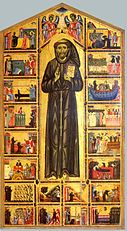 St. Francis and scenes from his life, 13th century
St. Francis and scenes from his life, 13th century
-
 Saint Francis of Assisi Receiving the Stigmata, Jan van Eyck, c. 1430–32. 29.3 cm × 33.4 cm (11.5 in × 13.1 in), Turin version
Saint Francis of Assisi Receiving the Stigmata, Jan van Eyck, c. 1430–32. 29.3 cm × 33.4 cm (11.5 in × 13.1 in), Turin version
-
 The Stigmatization of St Francis by Domenico Veneziano, (1445)
The Stigmatization of St Francis by Domenico Veneziano, (1445)
-
 Saint Francis in the Desert Giovanni Bellini, c. 1480, Frick Collection
Saint Francis in the Desert Giovanni Bellini, c. 1480, Frick Collection
-
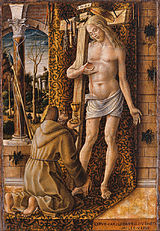 Saint Francis with the Blood of Christ Carlo Crivelli, c. 1500
Saint Francis with the Blood of Christ Carlo Crivelli, c. 1500
-
 El Greco - Saint Francis Receiving the Stigmata, 1585 until 1590
El Greco - Saint Francis Receiving the Stigmata, 1585 until 1590
-
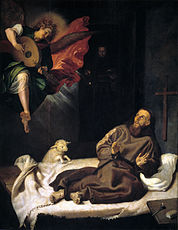 Francisco Ribalta, Francis of Assisi with angel music, c. 1620
Francisco Ribalta, Francis of Assisi with angel music, c. 1620
-
 Saint Francis in Meditation,oil painting by Francisco de Zurbarán (1639)
Saint Francis in Meditation,oil painting by Francisco de Zurbarán (1639)
-
 Saint Francis of Assisi in Ecstasy by Jusepe de Ribera, (1639)
Saint Francis of Assisi in Ecstasy by Jusepe de Ribera, (1639)
-
 Saint Francis of Assisi in Ecstasy, Caravaggio (c.1595)
Saint Francis of Assisi in Ecstasy, Caravaggio (c.1595)
-
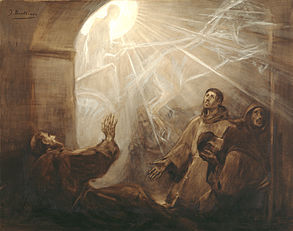 Francis of Assisi visiting his convent while far away, in a chariot of fire by José Benlliure y Gil, (1855–1937)
Francis of Assisi visiting his convent while far away, in a chariot of fire by José Benlliure y Gil, (1855–1937)
-
 The Ecstasy of St. Francis, Stefano di Giovanni (1392–1450) 1444
The Ecstasy of St. Francis, Stefano di Giovanni (1392–1450) 1444
-
 Jacopo Chimenti
Jacopo Chimenti
Media
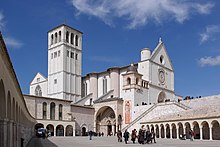



Films
- The Flowers of St. Francis, a 1950 film directed by Roberto Rossellini and co-written by Federico Fellini
- Francis of Assisi, a 1961 film directed by Michael Curtiz, based on the novel The Joyful Beggar by Louis de Wohl
- Francis of Assisi, a 1966 film directed by Liliana Cavani
- Uccellacci e uccellini (The Hawks and the Sparrows), a 1966 film directed by Pier Paolo Pasolini
- Brother Sun, Sister Moon, a 1972 film by Franco Zeffirelli
- Francesco, a 1989 film by Liliana Cavani, contemplatively paced, follows Francis of Assisi's evolution from rich man's son to religious humanitarian, and eventually to full-fledged self-tortured saint. Saint Francis is played by Mickey Rourke, and the woman who later became Saint Clare, is played by Helena Bonham Carter
- St. Francis, a 2002 film directed by Michele Soavi, starring Raoul Bova and Amélie Daure
- Clare and Francis, a 2007 film directed by Fabrizio Costa, starring Mary Petruolo and Ettore Bassi
- Pranchiyettan and the Saint, a 2010 satirical Indian Malayalam film
Music
- Franz Liszt:
- Cantico del sol di Francesco d'Assisi, S.4 (sacred choral work, 1862, 1880–81; versions of the Prelude for piano, S. 498c, 499, 499a; version of the Prelude for organ, S. 665, 760; version of the Hosannah for organ and bass trombone, S.677)
- St. François d'Assise: La Prédication aux oiseaux, No. 1 of Deux Légendes, S.175 (piano, 1862–63)
- William Henry Draper: All Creatures of Our God and King (hymn paraphrase of Canticle of the Creatures, published 1919)
- Mario Castelnuovo-Tedesco: Fioretti (voice and orchestra, 1920)
- Gian Francesco Malipiero: San Francesco d'Assisi (soloists, chorus and orchestra, 1920–21)
- Amy Beach: Canticle of the Sun (soloists, chorus and orchestra, 1928)
- Paul Hindemith: Nobilissima Visione (ballet 1938)
- Leo Sowerby: Canticle of the Sun (cantata for mixed voices with accompaniment for piano or orchestra, 1944)
- Francis Poulenc: Quatre petites prières de Saint François d'Assise (men's chorus, 1948)
- Seth Bingham: The Canticle of the Sun (cantata for chorus of mixed voices with soli ad lib. and accompaniment for organ or orchestra, 1949)
- William Walton: Cantico del sol (chorus, 1973–74)
- Olivier Messiaen: Saint François d'Assise (opera, 1975–83)
- Juliusz Łuciuk: Święty Franciszek z Asyżu (oratorio for soprano, tenor, baritone, mixed chorus and orchestra, 1976)
- Michele Paulicelli: Forza Venite Gente (musical theater, 1981)
- Karlheinz Stockhausen: Luzifers Abschied (1982), scene 4 of the opera Samstag aus Licht
- Libby Larsen: I Will Sing and Raise a Psalm (SATB chorus and organ, 1995)
- Sofia Gubaidulina: Sonnengesang (solo cello, chamber choir and percussion, 1997)
- Juventude Franciscana (JUFRA): Balada de Francisco (voices accompanied by guitar, 1999)
- Lewis Nielson: St. Francis Preaches to the Birds (chamber concerto for violin, 2005)
Books
- Francis of Assisi, The Little Flowers (fioretti), London, 2012. limovia.net ISBN 978-1-78336-013-0
- Saint Francis of Assisi, written and illustrated by Demi, Wisdom Tales, 2012, ISBN 978-1-937786-04-5
- Francis of Assisi: A New Biography, by Augustine Thompson, O.P., Cornell University Press, 2012, ISBN 978-080145-070-9
- Francis of Assisi in the Sources and Writings, by Robert Rusconi and translated by Nancy Celaschi, Franciscan Institute Publications, 2008. ISBN 978-1-57659-152-9
- The Stigmata of Francis of Assisi, Franciscan Institute Publications, 2006. ISBN 978-1-57659-140-6
- Francis of Assisi – The Message in His Writings, by Thaddee Matura, Franciscan Institute Publications, 1997. ISBN 978-1-57659-127-7
- Saint Francis of Assisi, by John R. H. Moorman, Franciscan Institute Publications, 1987. ISBN 978-0-8199-0904-6
- First Encounter with Francis of Assisi, by Damien Vorreux and translated by Paul LaChance, Franciscan Institute Publications, 1979. ISBN 978-0-8199-0698-4
- St. Francis of Assisi, by Raoul Manselli, Franciscan Institute Publications, 1985. ISBN 978-0-8199-0880-3
- Saint Francis of Assisi, by Thomas of Celano and translated by Placid Hermann, Franciscan Institute Publications, 1988. ISBN 978-0-8199-0554-3
- Francis the Incomparable Saint, by Joseph Lortz, Franciscan Institute Publications, 1986, ISBN 978-1-57659-067-6
- Respectfully Yours: Signed and Sealed, Francis of Assisi, by Edith van den Goorbergh and Theodore Zweerman, Franciscan Institute Publications, 2001. ISBN 978-1-57659-178-9
- The Admonitions of St. Francis: Sources and Meanings, by Robert J. Karris, Franciscan Institute Publications, 1999. ISBN 978-1-57659-166-6
- We Saw Brother Francis, by Francis de Beer, Franciscan Institute Publications, 1983. ISBN 978-0-8199-0803-2
- Sant Francesc (Saint Francis, 1895), a book of forty-three Saint Francis poems by Catalan poet-priest Jacint Verdaguer, three of which are included in English translation in Selected Poems of Jacint Verdaguer: A Bilingual Edition, edited and translated by Ronald Puppo, with an introduction by Ramon Pinyol i Torrents (University of Chicago, 2007). The three poems are "The Turtledoves", "Preaching to Birds" and "The Pilgrim".
- Saint Francis of Assisi (1923), a book by G. K. Chesterton
- Blessed Are The Meek (1944). a book by Zofia Kossak
- Saint Francis of Assisi a Doubleday Image Book translated by T. O'Conor Sloane, Ph.D., LL.D. in 1955 from the Danish original researched and written by Johannes Jorgensen and published in 1912 by Longmans, Green and Company, Inc.
- Saint Francis of Assisi (God's Pauper) (1962), a novel by Nikos Kazantzakis
- Scripta Leonis, Rufini Et Angeli Sociorum S. Francisci: The Writings of Leo, Rufino and Angelo Companions of St. Francis (1970), edited by Rosalind B. Brooke, in Latin and English, containing testimony recorded by intimate, long-time companions of St. Francis
- Saint Francis and His Four Ladies (1970), a book by Joan Mowat Erikson
- The Life and Words of St. Francis of Assisi (1973), by Ira Peck
- The Life of Saint Francis of Assisi (1996), a book by Patricia Stewart
- Reluctant Saint: The Life of Francis of Assisi (2002), a book by Donald Spoto
- Flowers for St. Francis (2005), a book by Raj Arumugam
- Chasing Francis, 2006, a book by Ian Cron
- John Tolan, St. Francis and the Sultan: The Curious History of a Christian-Muslim Encounter. Oxford: Oxford University Press, 2009.
- Vita di un uomo: Francesco d'Assisi (1995) a book by Chiara Frugoni, preface by Jacques Le Goff, Torino: Einaudi.
- Francis, Brother of the Universe (1982), a 48 page comic book by Marvel Comics on the life of Saint Francis of Assisi written by Father Roy Gasnik O.F.M. and Mary Jo Duffy, artwork by John Buscema and Marie Severin, lettering by Jim Novak and edited by Jim Shooter.
Other
| Part of a series on |
| Eucharistic adoration of the Catholic Church |
|---|
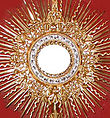 Solar monstrance of the Eucharist Solar monstrance of the Eucharist |
| Papal documents |
| Organisations and events |
| Notable individuals |
| Eucharistic meditators |
|
|
- In Rubén Darío's poem Los Motivos Del Lobo (The Reasons Of The Wolf) St. Francis tames a terrible wolf only to discover that the human heart harbors darker desires than those of the beast.
- In Fyodor Dostoyevsky's The Brothers Karamazov, Ivan Karamazov invokes the name of 'Pater Seraphicus,' an epithet applied to St. Francis, to describe Alyosha's spiritual guide Zosima. The reference is found in Goethe's "Faust," Part 2, Act 5, lines 11918–25.
- Rich Mullins co-wrote Canticle of the Plains, a musical, with Mitch McVicker. Released in 1997, it was based on the life of St. Francis of Assisi, but told as a western story.
- Bernard Malamud's novel The Assistant (1957) features a protagonist, Frank Alpine, who exemplifies the life of St. Francis in mid-20th-century Brooklyn, New York City.
See also
- List of places named after Saint Francis
- Saint Benedict, who founded the Benedictine Monastery
- Fraticelli
- Saint Juniper, one of Francis' original followers
- Canticle of the Sun is a prayer by St. Francis.
- Prayer of Saint Francis is not a prayer by St. Francis.
- St. Benedict's Cave, which contains a portrait of Francis made during his lifetime
- Saint Margaret of Cortona
- Saint-François d'Assise, an opera by Olivier Messiaen
- Saint-François (disambiguation) (places named after Francis of Assisi in French-speaking countries)
- Society of Saint Francis
- List of Catholic saints
Notes
- On the day of his election, the Vatican clarified that his official papal name was "Francis", not "Francis I". A Vatican spokesman said that the name would become Francis I if and when there is a Francis II.
References
- ^ Brady, Ignatius Charles. "Saint Francis of Assisi." Encyclopædia Britannica Online.
- ^ Chesterton (1924), p.126
- ^ Paschal Robinson (1913). "St. Francis of Assisi" . In Herbermann, Charles (ed.). Catholic Encyclopedia. New York: Robert Appleton Company.
- ^ Cross, F. L., ed. (2005). "Francis of Assisi". The Oxford dictionary of the Christian church. New York: Oxford University Press. ISBN 0199566712.
- Tolan, John (2009). St. Francis and the Sultan: The Curious History of a Christian-Muslim Encounter. Oxford: Oxford University Press. ISBN 9780199239726.
- Cross, F. L., ed. (2005). "Stigmatization". The Oxford dictionary of the Christian church. New York: Oxford University Press. ISBN 0199566712.
- ^ "Blessing All Creatures, Great and Small". Duke Magazine. November 2006. Retrieved 2007-07-30.
- "St. Francis of Assisi – Franciscan Friars of the Renewal". Franciscanfriars.com. Retrieved 24 October 2012.
- under subheading "The Crib (Creche) or Nativity Scene"
- ^ Englebert, Omer (1951). The Lives of the Saints. New York: Barnes & Noble. p. 529. ISBN 978-1-56619-516-4.
- Robinson, P. (2009). St. Francis of Assisi. In The Catholic Encyclopedia. New York: Robert Appleton Company. Retrieved 2011-10-17 from New Advent.
- ^ Chesterton, Gilbert Keith (1924). "St. Francis of Assisi" (14 ed.). Garden City, New York: Image Books: 158.
{{cite journal}}: Cite journal requires|journal=(help) Cite error: The named reference "Chesterton" was defined multiple times with different content (see the help page). - Chesterton (1924), pp. 40–41
- Bonaventure; Cardinal Manning (1867). The Life of St. Francis of Assisi (from the Legenda Sancti Francisci) (1988 ed.). Rockford, Illinois: TAN Books & Publishers. p. 190. ISBN 978-0-89555-343-0.
- ^ Chesterton (1924), pp. 54–56
- Saint Francis of Assisi by Jacques Le Goff 2003 ISBN 0-415-28473-2 page 44
- The Word made flesh: a history of Christian thought by Margaret Ruth mi 2004 ISBN 978-1-4051-0846-1 pages 160–161
- Chesterton (1924), pp. 107–108
- Galli(2002), pp. 74–80
- ^ Chesterton (1924), pp. 110–111
- Fioretti quoted in: St. Francis, The Little Flowers, Legends, and Lauds, trans. N. Wydenbruck, ed. Otto Karrer (London: Sheed and Ward, 1979) 244.
- ^ Chesterton (1924), p.130
- Steven Runciman, History of the Crusades, vol. 3: The Kingdom of Acre and the Later Crusades, Cambridge University Press (1951, paperback 1987), pp. 151–161.
- Tolan, St. Francis and the Sultan: the curious history of a Christian-Muslim encounter, Oxford University Press (2009) pp. 4f.
- e.g., Jacques de Vitry, Letter 6 of February or March 1220 and Historia orientalis (c. 1223–1225) cap. XXII; Tommaso da Celano, Vita prima (1228), §57: the relevant passages are quoted in an English translation in Tolan, pp. 19f. and 54 respectively.
- Tolan, p.5
- Bonaventure, Legenda major (1260–1263), cap. IX §7–9, criticized by, e.g., Sabatier, La Vie de St. François d'Assise (1894), chapter 13, and Paul Moses, The Saint and the Sultan: The Crusades, Islam, and Francis of Assisi's Mission of Peace, Doubleday Religion (2009) excerpted in an article "Mission improbable: St. Francis & the Sultan", in Commonwealth magazine, September 25, 2009.
- e.g., Chesterton, Saint Francis, Hodder & Stoughton (1924) chapter 8.
- Péter Bokody, "Idolatry or Power: St. Francis in Front of the Sultan," In Promoting the Saints: Cults and Their Contexts from Late Antiquity until the Early Modern Period, ed. Ottó Gecser and others(Budapest: CEU Press, 2010), 69-81. https://www.academia.edu/1787059/Idolatry_or_Power_St._Francis_in_Front_of_the_Sultan
- For grants of various permissions and privileges to Francis as attributed by later sources, see, e.g., Tolan, pp. 258–263. The first mention of the Sultan's conversion occurs in a sermon delivered by Bonaventure on October 4, 1267. See Tolan, pp. 168
- Bulla Gratias agimus, commemorated by Pope John Paul II in a Letter dated November 30, 1992. See also Tolan, p.258. On the Franciscan presence, including an historical overview, see, generally the official website at Custodia and Custodian of the Holy Land
- ^ Bonaventure (1867), p. 178
- "Italy/Subiaco". www.paradoxplace.com.
- Bonaventure (1867), p. 162
- ^ Chesterton (1924), p.131
- ^ Bonaventure (1867), pp. 78–85
- Ugolino Brunforte (Brother Ugolino). The Little Flowers of St. Francis of Assisi. Calvin College: CCEL. ISBN 1-61025212-8. ISBN 978-1-61025212-6.
Quote.
{{cite book}}: External link in|quote= - Pope John Paul II (November 29, 1979). "Inter Sanctos (Apostolic Letter AAS 71)" (PDF). Retrieved August 7, 2014.
- Pope John Paul II (December 8, 1989). "World Day of Peace 1990". Retrieved October 24, 2012.
- Calendarium Romanum (Libreria Editrice Vaticana), p. 139
- Pope Pius XII (June 18, 1939). "Licet Commissa" (Apostolic Letter AAS 31, pp. 256–257)
- Pope Francis (March 16, 2013). "Audience to Representatives of the Communications Media". Retrieved August 9, 2014.
- "Pope Francis explains decision to take St Francis of Assisi's name". London: The Guardian. 16 March 2013. Archived from the original on 16 March 2013.
- ^ "New Pope Fracis visits St. Mary Major, collects suitcases and pays bill at hotel". NEWS.VA. 14 March 2013. Archived from the original on 16 March 2013.
- Michael Martinez, CNN Vatican analyst: Pope Francis' name choice 'precedent shattering', CNN (13 March 2013). Retrieved 13 March 2013.
- Laura Smith-Spark et al. : Pope Francis explains name, calls for church 'for the poor' CNN,16 March 2013
- "Pope Francis wants 'poor Church for the poor'". BBC News. BBC. 16 March 2013. Retrieved 16 March 2013.
- Bethune, Brian, "Pope Francis: How the first New World pontiff could save the church", macleans.ca, 26 March 2013, Retrieved 27 March 2013
- Alpert, Emily (13 March 2013). "Vatican: It's Pope Francis, not Pope Francis I". Los Angeles Times. Archived from the original on 16 March 2013.
- The complete list of writings of St. Francis
- Brand, Peter; Pertile, Lino, eds. (1999). "2 - Poetry. Francis of Assisi (pp. 5ff.)". The Cambridge History of Italian Literature. Cambridge University Press. ISBN 0-52166622-8. ISBN 978-0-52166622-0.
{{cite book}}: External link in|chapterurl=|editor2link=ignored (|editor-link2=suggested) (help) - Chesterton, G.K. (1987). St. Francis. Image. pp. 160 p. ISBN 0-385-02900-4.
- Renoux, Christian (2001). La prière pour la paix attribuée à saint François: une énigme à résoudre. Paris: Editions franciscaines. ISBN 2-85020-096-4.
- Renoux, Christian. "The Origin of the Peace Prayer of St. Francis". Retrieved August 9, 2014.
Bibliography
- Scripta Leonis, Rufini et Angeli Sociorum S. Francisci: The Writings of Leo, Rufino and Angelo Companions of St. Francis, original manuscript, 1246, compiled by Brother Leo and other companions (1970, 1990, reprinted with corrections), Oxford, Oxford University Press, edited by Rosalind B. Brooke, in Latin and English, ISBN 0-19-822214-9, containing testimony recorded by intimate, long-time companions of St. Francis
- Francis of Assisi, The Little Flowers (fioretti), London, 2012. limovia.net ISBN 978-1-78336-013-0
- Bonaventure; Cardinal Manning (1867). The Life of St. Francis of Assisi (from the Legenda Sancti Francisci) (1988 ed.). Rockford, Illinois: TAN Books & Publishers. ISBN 978-0-89555-343-0
- Chesterton, Gilbert Keith (1924). St. Francis of Assisi (14 ed.). Garden City, New York: Image Books.
- Englebert, Omer (1951). The Lives of the Saints. New York: Barnes & Noble.
- Karrer, Otto, ed., St. Francis, The Little Flowers, Legends, and Lauds, trans. N. Wydenbruck, (London: Sheed and Ward, 1979)
- Robinson, Paschal (1913). "St. Francis of Assisi". Catholic Encyclopedia. New York: Robert Appleton Company. Herbermann, Charles, ed. (1913). "St. Francis of Assisi" . Catholic Encyclopedia. New York: Robert Appleton Company.
Further reading
- Friar Elias, Epistola Encyclica de Transitu Sancti Francisci, 1226.
- Pope Gregory IX, Bulla "Mira circa nos" for the canonization of St. Francis, July 19, 1228.
- Friar Tommaso da Celano: Vita Prima Sancti Francisci, 1228; Vita Secunda Sancti Francisci, 1246–1247; Tractatus de Miraculis Sancti Francisci, 1252–1253.
- Friar Julian of Speyer, Vita Sancti Francisci, 1232–1239.
- St. Bonaventure of Bagnoregio, Legenda Maior Sancti Francisci, 1260–1263.
- Ugolino da Montegiorgio, Actus Beati Francisci et sociorum eius, 1327–1342.
- Fioretti di San Francesco, the "Little Flowers of St. Francis", end of the 14th century: an anonymous Italian version of the Actus; the most popular of the sources, but very late and therefore not the best authority by any means.
- The Little Flowers of Saint Francis (Translated by Raphael Brown), Doubleday, 1998. ISBN 978-0-385-07544-2
- Acocella, Joan, "Rich Man, Poor Man: The Radical Visions of St. Francis", The Critics: Books, The New Yorker 88, no. 43 (January 14, 2013): 72-77 (accessed January 23, 2015).
External links
- "Saint Francis of Assisi", Encyclopædia Britannica online
- "St. Francis of Assisium, Confessor", Butler's Lives of the Saints
- The Franciscan Archive
- St. Francis of Assisi - Catholic Saints & Angels
- St. Francis of Assisi at the Christian Iconography web site.
- Here Followeth the Life of St. Francis from Caxton's translation of the Golden Legend
| History of Christianity | |||||||||
|---|---|---|---|---|---|---|---|---|---|
| Centuries | |||||||||
| Origins and Apostolic Age | |||||||||
| Ante-Nicene period | |||||||||
| Late antiquity (Great Church) | |||||||||
| Catholicism | |||||||||
| Eastern Christianity | |||||||||
| Middle Ages |
| ||||||||
| Reformation and Protestantism |
| ||||||||
| 1640–1789 | |||||||||
| 1789–present |
| ||||||||
| Catholic Church | |||||||||||||
|---|---|---|---|---|---|---|---|---|---|---|---|---|---|
| History Timeline Ecclesiastical Legal |
| ||||||||||||
| Theology Bible Tradition Catechism |
| ||||||||||||
| Philosophy | |||||||||||||
| Saints | |||||||||||||
| Organisation Hierarchy Canon law Laity Precedence By country |
| ||||||||||||
| Culture | |||||||||||||
| Media | |||||||||||||
| Religious orders, institutes, societies |
| ||||||||||||
| Associations of the faithful | |||||||||||||
| Charities | |||||||||||||
| History of the Catholic Church | |||||||||
|---|---|---|---|---|---|---|---|---|---|
| General | |||||||||
| Early Church (30–325/476) |
| ||||||||
| Early Middle Ages | |||||||||
| High Middle Ages |
| ||||||||
| Late Middle Ages | |||||||||
| Protestant Reformation Counter-Reformation |
| ||||||||
| Baroque period to the French Revolution | |||||||||
| 19th century | |||||||||
| 20th century |
| ||||||||
| 21st century | |||||||||
| History of Catholic theology | |
|---|---|
| Key figures | |
| General | |
| Early Church | |
| Constantine to Pope Gregory I |
|
| Early Middle Ages | |
| High Middle Ages |
|
| Mysticism and reforms |
|
| Reformation Counter-Reformation |
|
| Baroque period to French Revolution |
|
| 19th century |
|
| 20th century |
|
| 21st century | |
| Francis of Assisi | ||
|---|---|---|
| Organisations | 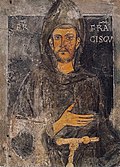 | |
| Works by Francis | ||
| Created | ||
| Honors | ||
| Literature about | ||
| Visual art |
| |
| Music |
| |
| Stage |
| |
| Films |
| |
| Related | ||
- 1180s births
- 1226 deaths
- People from Assisi
- Founders of Roman Catholic religious communities
- Franciscan spirituality
- Italian Friars Minor
- Italian Roman Catholic saints
- Roman Catholic saints
- Ascetics
- Roman Catholic deacons
- Franciscan mystics
- Renewers of the church
- Stigmatics
- Christian hymnwriters
- Beggars
- Italian Christian pacifists
- Burials in Assisi
- 12th-century Christian saints
- 13th-century Christian saints
- Saints of the Golden Legend
- Medieval Italian saints
- Anglican saints
- Francis of Assisi
- Christian radicals
- Angelic visionaries
